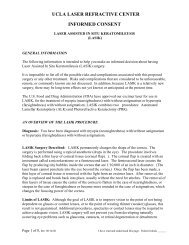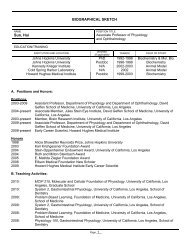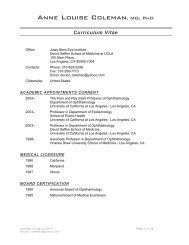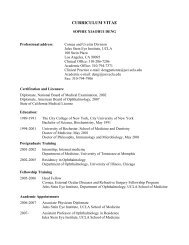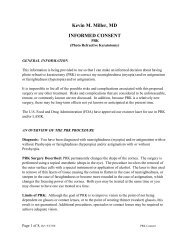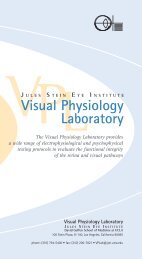View Annual Report - Jules Stein Eye Institute
View Annual Report - Jules Stein Eye Institute
View Annual Report - Jules Stein Eye Institute
You also want an ePaper? Increase the reach of your titles
YUMPU automatically turns print PDFs into web optimized ePapers that Google loves.
Gordon L. Fain, PhD<br />
Distinguished Professor of the Departments of<br />
Integrative Biology/Physiology and of Ophthalmology<br />
Member of the <strong>Jules</strong> <strong>Stein</strong> <strong>Eye</strong> <strong>Institute</strong><br />
ReseaRch summaRy<br />
Physiology of Photoreceptors<br />
in the Vertebrate <strong>Eye</strong><br />
Dr. Fain’s primary research interest is in the physiology<br />
of photoreceptors in the vertebrate eye. A vertebrate<br />
photoreceptor uses a photopigment called rhodopsin<br />
and a G-protein cascade to produce the electrical<br />
response that signals a change in light intensity.<br />
Powerful new techniques have made it possible to<br />
understand the working of this cascade in extraordinary<br />
detail. Practically all the protein molecules involved in<br />
the cascade in a photoreceptor—from the pigment<br />
molecule to the G-protein and channels, but also<br />
including a large number of control proteins—are<br />
expressed only in the photoreceptors and nowhere else<br />
in the body. This has enabled scientists to use genetic<br />
techniques to create mice in which these proteins<br />
have been knocked out, over- or under-expressed, or<br />
replaced with proteins of modified structure.<br />
Dr. Fain’s laboratory uses electrical recording to study<br />
the effects of such genetic alterations on the light<br />
responses of mouse rods, in order to understand<br />
the role of these proteins in the visual cascade. His<br />
research team is especially interested in modulatory<br />
enzymes and their function in light and dark adaptation.<br />
Dr. Fain also has a long-standing interest in mechanisms<br />
of photoreceptor degeneration in genetically<br />
inherited disease. His laboratory is presently the only<br />
laboratory measuring changes in calcium from mouse<br />
rods with fluorescent dyes. Findings have implicated<br />
both increases and decreases in calcium concentration<br />
as contributing factors in the triggering of apoptosis.<br />
Such information may provide insight into the mechanisms<br />
of retinal degeneration.<br />
36 Faculty | Fain<br />
Research Grants<br />
National <strong>Eye</strong> <strong>Institute</strong>: Physiology of Photoreceptors,<br />
8/1/08–7/31/12




